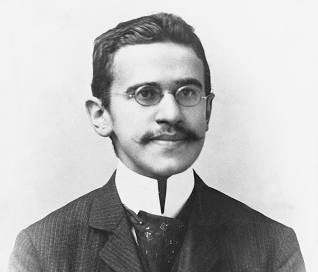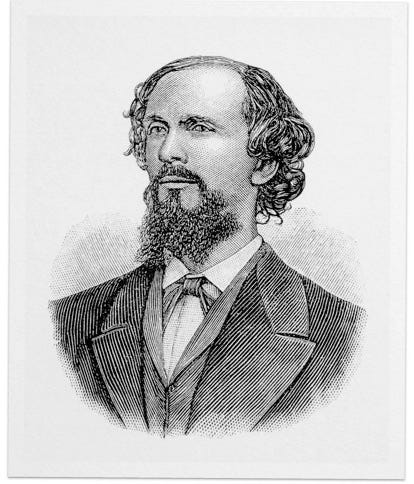A Scandal, a Suicide and the Spectrum of Sex.
The trans lobby's most cherished idea, that there is a spectrum of the sexes, was invented by a self-loathing anti-semite who believed women were not fully human and was a favourite of the Nazis.
Part Two of the Clitoris Club: the Anti-Semitic Connection
“In the days before the war there was growing in London, beyond any sort of question, that passion for excitement and for the latest novelty which is always the familiar beginning of a corrupt society ... If one of the consequences of the Billing case is to give new value to the ancient virtues ... then there may be some compensation after all for the work of a scandalous week.” - The Times, 5 June 1918
This quote from the Times captures one of the themes of World War One which is little mentioned now. War, it was hoped by many traditionalists on both sides, would cleanse the nation. In the life or death struggle of the trenches, valour and manhood would be reborn they argued, shorn of the corruption and effeminate decadence they associated with the Belle Epoque. These champions of the old moral values failed to recognise, of course, that in order for young men to be revitalised they must first avoid being pulped into mud or blown into pieces. In their millions.
I wrote two weeks ago about the trial that dominated the British press at a key moment of World War One and the conspiracy theory about lesbians in powerful places that inspired it. You may remember, the performer Maud Allen sued Noel Pemberton Billing MP, claiming he had ruined her reputation. In his magazine The Vigilante, Billing had alleged Allen was a pivotal figure in the Clitoris Cult, a high-level plot directed by the German High Command to turn the wives of the British Establishment into confirmed muff-munchers.
According to the magazine, Allen’s role in this conspiracy was to inflame the latent lesbian passions of prominent women. Not an entirely unfeasible goal if you looked like Maud, I suppose.
One of the many things about the court case that shocked the general public was it suddenly seemed to reveal a world of shameless homosexual activity hiding in plain sight. A world, people assumed, had been stamped out with Oscar Wilde’s disgrace two decades before.
It was true that, after Wilde was jailed in 1895, a chill swept through the secretive haunts of homosexual men in London. And after a spate of blackmails a number of well-connected or wealthy men suddenly remembered they’d always meant to do more travelling in warmer and less judgmental climes. Morocco, Tunisia, Venice and the island of Capri, among others.
Back in Blighty, in what the Carry On films might have called the err….throbbing centre of the homosexual demi-monde, life became, if not exactly quiet, then less openly hectic than in Wilde’s heyday. The well-trodden triangle that ran between the playwright’s favourite watering hole of the Cafe Royal in Piccadilly, the rustling bushes of Hyde Park and the …barracks of the Horse Guards in St James’s still buzzed with homosexuals on the pull even if the increase in police monitoring meant courtship was more low-key. Gone were the more overt signals of homosexuality like the dyed green carnations on lapels that Wilde urged his friends to wear.
By the way, if you are wondering why a military barracks might be one of the magnetic poles of gay life in London, let’s just say that in Victorian England the Horse Guards were the Queen’s favourite regiment in more ways than one. For stories about them and their homosexual fans that are often quite jaw-dropping (so to speak) I recommend a remarkable book by Rupert Croft-Cooke, called ‘Feasting With Panthers’ from 1967. Here’s my copy being photobombed by a badly behaved geranium.
It took almost a decade after Wilde’s death in 1900 for the homosexual milieu of London to recover some of its previous boldness. In the bohemian circles of Fitzrovia and Soho, where new ideas and artistic innovation flourished, homosexual men and women found they could let their guard down. This was the era of the Rite of Spring, Cubism, and the Futurists as well as occultist fads such as theosophy and rosicrucianism. All found enthusiastic support from what seemed an increasingly cosmopolitan plutocracy. But what did these literary and artistic cliques think about the issues that populate what we now dub the gender wars? You may be surprised.
I mentioned last time that Psychopathia Sexualis, the work of the psychiatrist Richard Kraft-Ebing, became a persistent feature of the Maud Allen trial. His claims that women could be born in male bodies and vice versa were cited as evidence by Billing in his defence and thereby ended up on the front pages. This was the first time such a notion reached a mass audience. But for a substantial section of the educated elite it was far from that. Psychopathia Sexualis published in 1888, was widely read and had found a particularly keen readership among those who knew- or feared - they were sexually attracted to people of the same sex. This meant the ridiculous, almost occult notion of people being born into the wrong sexed body had, by the time of the Maud Allen trial, already inserted itself into the consciousness of the people involved in the incipient stirrings of what would eventually become the gay liberation movement.
In fact it had been percolating for some time. After all, it wasn’t as if Krafft-Ebing had actually invented the notion of being born in the wrong sexed body. His work drew on that of a predecessor, another German, who has been credited with creating both the academic study of homosexuality and the campaign for civil rights for homosexuals. Unfortunately, Karl Heinrich Ulrichs also devised the toxic fantasy that women could be trapped in a male body, etcetera…etcetera.





